Editors Note: As I was reading Tex Wyndham’s book of collected Shouts this spring I had a growing feeling that they should be shared again. It was this column, encouraging women to join the band, that tipped the scales for me.
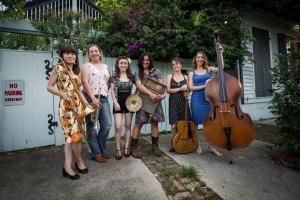
I was at the time reviewing a new CD from the fantastic Shake Em’ Up Jazz Band, an all-women group whose members play as instrumentalists in other bands. All-female groups date back to the thirties, and recently we’ve enjoyed Mighty Aphrodite, one of Bria Skonberg‘s early groups, and Cynthia Sayer‘s Women of the World Jazz Band. It is an appealing gimmick.
But in September, as part of a Women Take The Lead column I reviewed a CD by Megan and Her Goody Goodies on which five out of eight members were women, not for any other reason than that they were the best musicians available. That’s real progress. I’m also aware of many many other women receiving accolades for their supporting roles in bands.

But, most of what Tex identifies in this article will still ring true. Women make up not nearly half of active traditional jazz instrumentalists and most bands still only have women in a vocal role.
That is what I like about these columns. They speak to how some things stay the same while others change within the music itself, among the people who play it, and in the jazz community as a whole. Running from 29 years in the past until a mere 22 years ago they are a peek not into the distance but back a single generation. Two points in time just far enough apart to gauge our trajectory going forward.
To celebrate our progress I’ve illustrated this column with pictures of women making it in traditional jazz today. You may also enjoy reading our interview with Viola Smith, a first generation jazz drummer, on the occasion of her 106th Birthday. -Joe Bebco
Women in Dixieland
Set forth below is the twelfth “Texas Shout” column. It first appeared in the November 1990 issue of The West Coast Rag, now known as The Syncopated Times. The text has not been updated.
All of us would like to see more people involved with Dixieland jazz. I can think of just one simple little thing that would need to happen for the number of Dixieland musicians to double, approximately speaking.
I have been unable to figure out why it doesn’t happen, so I thought I’d try discussing the subject with you. Maybe you can tell me what I’m missing.
What the Dixieland community needs is for women to become as interested in playing the music as men are. Almost all Dixieland instrumentalists are, and always have been, male. Why is that?
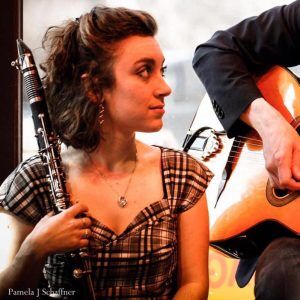
Are women less interested in Dixieland than men? I can’t buy that. Women are just about equally represented in all aspects of the scene these days except playing. They run jazz clubs, edit and publish jazz newsletters and magazines, deal in vintage sheet music, produce jazz festivals, volunteer in all aspects of festival and club activities, and make up half the audience at performances.
Do women get less instrumental training than men? I don’t think so, but let’s examine that thought for a moment.
No one, neither male nor female, gets much training on two instruments commonly found in Dixieland bands, tuba and banjo. With few exceptions, these axes are “manned” by individuals who decided on their own to play those particular instruments. Such folks are typically self-taught or seek out lessons for the specific purpose of learning to play in a Dixieland context.
Why is such a self-starting thrust to play those two instruments so predominantly male? Perhaps the size and weight of the tuba explains the dearth of distaff tubaists, but not of banjo.
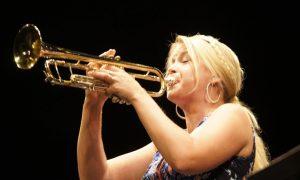
To be sure, those women who play Dixieland are most likely to be playing banjo or piano (the instrument that, at least when I was a kid, was most commonly taught to youngsters of both sexes). However, the proportion of female pluckers and ticklers is nowhere near the 50% you might expect. Why not?
The question is particularly puzzling when you consider the clarinet. Judging from the virtually all-female clarinet sections fielded by high school orchestras for several decades now, you might think the licorice stick has become an exclusively female preserve. And yet, looking at the festival stages, you’ll see that essentially none of these distaff stickmen has felt a calling to continue on into Dixieland. How come?
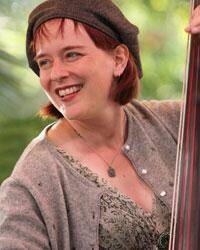
I asked this question in the April 1987 issue of The Mississippi Rag. In that column, I discussed a point raised by my lovely bride Nancy, who observed that women of our age and older (50 and up, that is) were raised under circumstances where it was not considered proper for a female to do anything so unladylike as playing Dixieland jazz. On the other hand, it was considered proper for a woman to be involved in activities that might cover more social aspects of the music, such as running a jazz club.
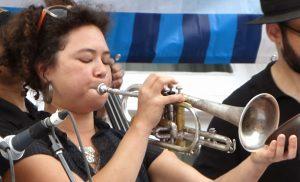
The following month, The Mississippi Rag ran a response by “Sister Jean” Huling, a noted ragtime pianist who’s been a friend of ours for years. I hope I am paraphrasing Jean accurately when I tell you that Jean said she agreed with Nancy, citing several instances in which she (Jean) felt subtle and sometimes not-so-subtle anti-female pressure from parents, other musicians, etc. when attempting to follow her heart and play Dixieland and ragtime.
Jean is obviously in a better position to address such matters than I, and I’m sure she is right in what she says. However, I am still not convinced that such pressures explain today’s lack of female Dixieland musicians.
In most locales, Dixieland jazz is not as easily found today as it was when Jean, Nancy and I were in our youth. When Dixieland is performed, the setting is much more likely to be one where a woman can go while feeling both safe and respectable, i.e., a jazz club or a festival as opposed to a late-hours tavern in a potentially threatening downtown area.
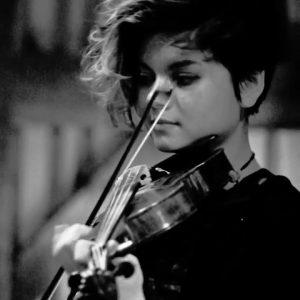
Moreover, times have changed a great deal. I believe that people in general are much more accepting than they used to be of a woman who decides to do her own thing.
My Red Lion Jazz Band has had, for quite a few years now, a female banjo player. Pat Meitzler decided some time ago that she wanted to play Dixieland; began attending our rehearsals; developed into a light, steady and reliable rhythm banjoist; and took over the chair when Bud Ahern died. We consider ourselves lucky that she was available.
As the bandleader, I think I’d know if there is any sort of resentment of Pat’s presence, but I’ve never felt a hint of any. However, just to be sure, while preparing this column, I discussed the subject with Pat.
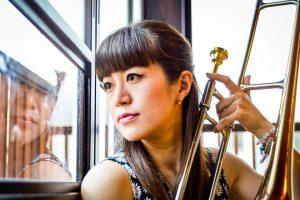
She confirmed my view. Pat told me she’s never sensed even a trace of sexist pressure.
In fact, her experience is quite the contrary. On the relatively few occasions when anyone has brought up the subject with her of a woman’s playing in a Dixieland band, Pat reports that she’s received universal approval and encouragement.
When a last-minute conflict required The Rent Party Revellers to recruit a new member to play piano on our first cruise, our choice was Rose Marie Barr, the excellent tickler with Seattle’s Uptown Lowdown Jazz Band. Not only did the question of gender never enter our minds, but we were overjoyed that such an accomplished musician was able to adjust her schedule to join the band. Thus, from my experience at least, I have a hard time believing that the disproportionately low number of female players on today’s scene is attributable in any significant way to anti-female attitudes.
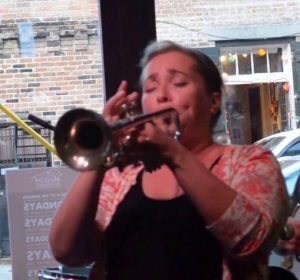
Moreover, whether or not non-Dixielanders, in general, feel unduly bound by convention, Dixielanders almost by definition are unconventional — that is, choosing to become involved with Dixieland jazz these days is itself an unconventional thing to do. The music is not commercially viable anymore. Although some festivals attract thousands of attendees, it is still true that the Dixieland jazz community is a minuscule part of the total population. The people who don’t care a fig about Dixieland are the “normal” ones — we are the oddballs in the crowd.
In these circumstances, a female who is deeply committed to the Dixieland club/festival scene, one who is interested enough to be reading these words, is already, in a sense, defying convention and swimming against the tide. Can there be any additional lingering conventions holding her back, if she’s ever had any instrumental training (or even if she hasn’t), from deciding to take just one more step and play the music itself?
On rare occasions, while getting ready to go out, and after I’ve gotten an update on the weather, I’ll switch the bedroom TV over to MTV as a way of making sure I’m prepared for the enemy’s next attack. I can’t stay with 1990s rock for more than a few minutes, but I have noticed something about it that’s relevant to today’s discussion.
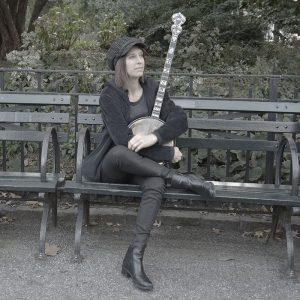
Rock is, as far as the division of the sexes is concerned, just like Dixieland. If you see a female on MTV, whether or not she has an instrument in her hand, she is almost always appearing primarily as a vocalist. The rockers who stay in purely instrumental roles are overwhelmingly male.
Now the rock scene, it seems to me, is about as unconventional and rebellious as you can get. If there’s a way to thumb one’s nose at the establishment in a musical context, I think you’ll find plenty of rockers who will jump at the chance to do so with a vengeance. Moreover, the rockers are almost all of an age to have been born and raised in a context of open public discussion of women’s lib.
Thus, I can’t imagine that there is any sort of anti-female bias in the rock world against women instrumentalists. Still, there aren’t any more of them than there are female Dixieland instrumentalists. Why not?
Just about everyone who plays Dixieland these days does so because he (or she) can’t really do otherwise. Although there is no longer any appreciable fame or fortune in the music, something within us compels us to spend time learning to play it and, when our abilities have reached a certain point, to appear before an audience. Is there something about that activity that appeals more to males than to females? If so, what?

I’ve wrestled with this question for years, and have no answer that satisfies me. In bringing it up in these pages, I do not intend to imply any sort of sexist sentiments in favor of either gender. If I’ve inadvertently done so anyway, I sincerely apologize.
However, loving the music as I do, I am disturbed that there continue to be, even in this liberated age, virtually no females deciding to play Dixieland. Said another way, fully half of the potential performers of Dixieland are choosing not to do so, a situation that should concern all of us who care about the music.
How’s about it, ladies? Do you still have your high school clarinet in the closet? Why not dust it off, take it to the local music store if necessary to get the pads or keys spruced up, and start to play along with some of the easier tunes on your favorite Dixieland records?
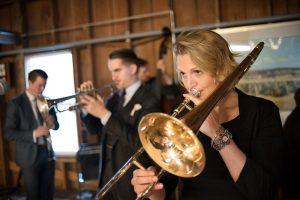
Several jazz clubs have regular jam sets as part of their monthly meetings, in which players of all levels of ability are cheerfully welcomed. Some also maintain chord books, and publish advance lists of suggested tunes for the monthly jams, to make it easier for neophytes to make their first steps onstage without embarrassment. Surely you ladies can function in that kind of situation as well as men, right?
Why not give it a try? And men — husbands, boyfriends, whatever — get yourselves on board via encouragement for such activities as your lady’s home practice, attending functions where your wife or companion wants to play, applauding good performances on stage or at jam sets without reference to the gender of the performer, etc.
Who knows? In a few years, we may have lots more Dixielanders out there. Isn’t that a goal toward which we’re all working?
Back to the Texas Shout Index.

The full run of “Texas Shout” has been collected into a lavishly illustrated trade paperback entitled Texas Shout: How Dixieland Jazz Works. This book is available @ $20.00 plus $2.95 shipping from Tex Wyndham, On request, Tex will autograph the book and add a personalized note (be sure to tell him to whom the note should be addressed).
Tex Wyndham’s 3 CD Guide to Dixieland with music and commentary is available for $20 plus $2.95 shipping. The separate CD, A History of Ragtime: Tex Wyndham Live At Santa Rosa, is available for $13.00 plus $2.00 shipping. On request, Tex will autograph the inner sleeve and add a personalized note (be sure to tell him to whom the note should be addressed).
Send payment to Tex Wyndham, P.O. Box 831, Mendenhall, PA 19357, Phone (610) 388-6330.
Note: All links, pictures, videos or graphics accompanying the Shouts were added at the discretion of the Syncopated Times editorial staff. They did not accompany the original columns and do not necessarily reflect the opinion of Tex Wyndham.
From roughly 1970-2010, Tex Wyndham was: (1) one of the best-known revivalist Dixieland jazz musicians in the US, as cornetist, pianist and bandleader, (2) one of the best-known ragtime pianists in the US, and (3) one of the most respected critics in the US of Dixieland jazz, ragtime, and related music. He is the only person about whom all three of those statements can be made.



















